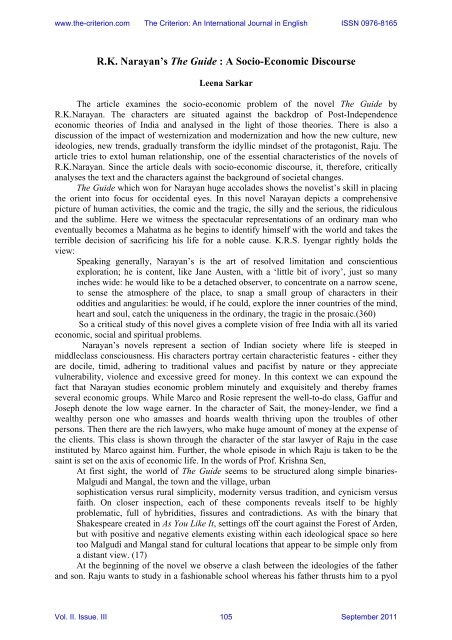Vol. II. Issue. III September 2011 - The Criterion: An International ...
Vol. II. Issue. III September 2011 - The Criterion: An International ...
Vol. II. Issue. III September 2011 - The Criterion: An International ...
You also want an ePaper? Increase the reach of your titles
YUMPU automatically turns print PDFs into web optimized ePapers that Google loves.
www.the-criterion.com <strong>The</strong> <strong>Criterion</strong>: <strong>An</strong> <strong>International</strong> Journal in English ISSN 0976-8165<br />
R.K. Narayan’s <strong>The</strong> Guide : A Socio-Economic Discourse<br />
Leena Sarkar<br />
<strong>The</strong> article examines the socio-economic problem of the novel <strong>The</strong> Guide by<br />
R.K.Narayan. <strong>The</strong> characters are situated against the backdrop of Post-Independence<br />
economic theories of India and analysed in the light of those theories. <strong>The</strong>re is also a<br />
discussion of the impact of westernization and modernization and how the new culture, new<br />
ideologies, new trends, gradually transform the idyllic mindset of the protagonist, Raju. <strong>The</strong><br />
article tries to extol human relationship, one of the essential characteristics of the novels of<br />
R.K.Narayan. Since the article deals with socio-economic discourse, it, therefore, critically<br />
analyses the text and the characters against the background of societal changes.<br />
<strong>The</strong> Guide which won for Narayan huge accolades shows the novelist’s skill in placing<br />
the orient into focus for occidental eyes. In this novel Narayan depicts a comprehensive<br />
picture of human activities, the comic and the tragic, the silly and the serious, the ridiculous<br />
and the sublime. Here we witness the spectacular representations of an ordinary man who<br />
eventually becomes a Mahatma as he begins to identify himself with the world and takes the<br />
terrible decision of sacrificing his life for a noble cause. K.R.S. Iyengar rightly holds the<br />
view:<br />
Speaking generally, Narayan’s is the art of resolved limitation and conscientious<br />
exploration; he is content, like Jane Austen, with a ‘little bit of ivory’, just so many<br />
inches wide: he would like to be a detached observer, to concentrate on a narrow scene,<br />
to sense the atmosphere of the place, to snap a small group of characters in their<br />
oddities and angularities: he would, if he could, explore the inner countries of the mind,<br />
heart and soul, catch the uniqueness in the ordinary, the tragic in the prosaic.(360)<br />
So a critical study of this novel gives a complete vision of free India with all its varied<br />
economic, social and spiritual problems.<br />
Narayan’s novels represent a section of Indian society where life is steeped in<br />
middleclass consciousness. His characters portray certain characteristic features - either they<br />
are docile, timid, adhering to traditional values and pacifist by nature or they appreciate<br />
vulnerability, violence and excessive greed for money. In this context we can expound the<br />
fact that Narayan studies economic problem minutely and exquisitely and thereby frames<br />
several economic groups. While Marco and Rosie represent the well-to-do class, Gaffur and<br />
Joseph denote the low wage earner. In the character of Sait, the money-lender, we find a<br />
wealthy person one who amasses and hoards wealth thriving upon the troubles of other<br />
persons. <strong>The</strong>n there are the rich lawyers, who make huge amount of money at the expense of<br />
the clients. This class is shown through the character of the star lawyer of Raju in the case<br />
instituted by Marco against him. Further, the whole episode in which Raju is taken to be the<br />
saint is set on the axis of economic life. In the words of Prof. Krishna Sen,<br />
At first sight, the world of <strong>The</strong> Guide seems to be structured along simple binaries-<br />
Malgudi and Mangal, the town and the village, urban<br />
sophistication versus rural simplicity, modernity versus tradition, and cynicism versus<br />
faith. On closer inspection, each of these components reveals itself to be highly<br />
problematic, full of hybridities, fissures and contradictions. As with the binary that<br />
Shakespeare created in As You Like It, settings off the court against the Forest of Arden,<br />
but with positive and negative elements existing within each ideological space so here<br />
too Malgudi and Mangal stand for cultural locations that appear to be simple only from<br />
a distant view. (17)<br />
At the beginning of the novel we observe a clash between the ideologies of the father<br />
and son. Raju wants to study in a fashionable school whereas his father thrusts him to a pyol<br />
<strong>Vol</strong>. <strong>II</strong>. <strong>Issue</strong>. <strong>II</strong>I 105 <strong>September</strong> <strong>2011</strong>
















